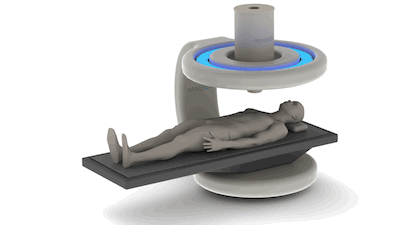This article represents the viewpoint of management.
Background
 The worldwide incidence of ovarian cancer is 12.6 per 100,000 women. In the year 2006, ovarian cancer was responsible for the deaths of 795 women in Australia, and in the year 2017, for the deaths of approximately 14,000 women in the US. Ovarian cancer is largely asymptomatic and often escapes detection until progression to late-stage disease. Women may exhibit non-specific symptoms such as abdominal pain and bloating, but these do not necessarily indicate the presence of serious disease. As a result, only a fifth of ovarian cancers are identified at an early disease stage, when it is most treatable. “In many cases, there are few or no symptoms until the cancer has progressed into later stages,” states an informational flyer for patients published by the American Medical Association. Given this context, it might be puzzling to learn that relatively low-cost screening tests for ovarian cancer exist, yet they are seldom used.
The worldwide incidence of ovarian cancer is 12.6 per 100,000 women. In the year 2006, ovarian cancer was responsible for the deaths of 795 women in Australia, and in the year 2017, for the deaths of approximately 14,000 women in the US. Ovarian cancer is largely asymptomatic and often escapes detection until progression to late-stage disease. Women may exhibit non-specific symptoms such as abdominal pain and bloating, but these do not necessarily indicate the presence of serious disease. As a result, only a fifth of ovarian cancers are identified at an early disease stage, when it is most treatable. “In many cases, there are few or no symptoms until the cancer has progressed into later stages,” states an informational flyer for patients published by the American Medical Association. Given this context, it might be puzzling to learn that relatively low-cost screening tests for ovarian cancer exist, yet they are seldom used.
Why Not Screen Women for Ovarian Cancer?
The U.S. Preventive Services Task Force (USPSTF), an independent panel of national experts in disease prevention and evidence-based medicine, recently commissioned a study of the benefits and harms of screening for ovarian cancer in asymptomatic women not known to be at high risk for ovarian cancer. At the conclusion of the study, the USPSTF published a “Recommendation Statement” for medical practitioners, contending that screening for ovarian cancer does not reduce ovarian cancer mortality, and recommending against ovarian cancer screening in asymptomatic women. This position is in accord with the organization’s previous findings, presented in 2012, and is shared by numerous practice and patient advocacy groups, including the American College of Obstetrics and Gynecology, the American Cancer Society, the American College of Radiology, and the American Academy of Family Physicians.
Existing ovarian cancer screening methods can actually do more harm than good. Their diagnostic weaknesses fall into two categories: insufficient sensitivity, and false-positive results. Current imaging methods for diagnosis and staging of ovarian cancer include ultrasound imaging, and, less frequently, X-ray. Unfortunately, neither of these methods can reliably distinguish between a benign mass and malignant disease mass with the sensitivity needed to catch ovarian cancer in an early, treatable stage. Similarly, manual pelvic examination has also been found unreliable for early-stage ovarian cancer detection.
 The study commissioned by USPSTF also evaluated evidence related to the use of serum levels of Cancer Antigen 25 (CA 125) as an ovarian cancer diagnostic. Though highly accessible as a routine blood test, CA 125 has not been found to be accurate for predicting ovarian cancer because a variety of factors other than ovarian cancer can cause serum levels to fluctuate.
The study commissioned by USPSTF also evaluated evidence related to the use of serum levels of Cancer Antigen 25 (CA 125) as an ovarian cancer diagnostic. Though highly accessible as a routine blood test, CA 125 has not been found to be accurate for predicting ovarian cancer because a variety of factors other than ovarian cancer can cause serum levels to fluctuate.
In cases where ovarian cancer is ultimately determined to be not present, preceding clinical findings of elevated serum levels of CA 125 or suspicious masses discovered by ultrasound imaging, X-ray, or pelvic examination are deemed “false positives.” In ovarian cancer medicine, false positives are a serious issue. When a positive ovarian cancer test occurs, diagnostic guidelines recommend invasive surgical biopsy with possible removal of one or both ovaries and fallopian tubes to determine whether cancer is present. However, the USPSTF Recommendation Statement notes that most women with a positive screening test do not have ovarian cancer. These women are therefore unnecessarily exposed to the surgical risks of biopsy, and, potentially, oophorectomy and its long-term, irreversible effects on fertility and endocrine function. In light of the inability of current screening methods to detect small ovarian tumors, and the likelihood of false positive test results, the USPSTF recommendation against routine ovarian cancer screening of asymptomatic women no longer seems callous or foolish, but rather compassionate and prudent.
The US Preventive Services Task Force recognizes the continuous nature of research progress and the opportunities this brings to improve medical practice. Although their recommendations did not change, the 2018 USPSTF study of the benefits and harms of screening for ovarian cancer was undertaken to consider new evidence produced since their previous findings on the same matter were presented in 2012. In a future study, the Task Force will have the opportunity to consider new evidence pointing to the potential predictive value of CA 125 screening when serum levels are evaluated for change over time, rather than for the relationship of a single measurement to a threshold value.
Early Detection is Key
Ovarian tumors must grow to sufficiently large mass before ultrasound imaging or other current diagnostic methods can detect them. As an unfortunate consequence, approximately 60% of women have distant spread of disease (metastasis) at the time of diagnosis. Detection of ovarian cancer at earlier, localized stages, when it occurs, enables improved outcomes: the five-year survival rate for localized ovarian cancer is 93%. When ovarian cancer has already metastasized, the five-year survival rate drops to just 29%. Therefore, there is an urgent need for more sensitive and specific diagnostic methods for reliable, early, stage ovarian cancer detection.
Imagion Biosystems’ Ovarian Cancer Program
 Imagion Biosystems is developing MagSense® technology for accurate, highly sensitive detection of cancer based on tumor-targeting specificity of antibody-antigen recognition and the unique physical properties of superparamagnetic nanoparticles. Pre-clinical studies indicate that the MagSense technology will likely be several orders of magnitude more sensitive than conventional imaging methods.
Imagion Biosystems is developing MagSense® technology for accurate, highly sensitive detection of cancer based on tumor-targeting specificity of antibody-antigen recognition and the unique physical properties of superparamagnetic nanoparticles. Pre-clinical studies indicate that the MagSense technology will likely be several orders of magnitude more sensitive than conventional imaging methods.
Our scientific collaboration with the MD Anderson Cancer Center is aimed at developing a test that can detect ovarian cancer earlier than is possible using ultrasound or other current methods. Through this collaborative development program, we hope to provide oncologists and other cancer medicine specialists with a powerful new diagnostic method and the ability to save and improve the lives of women at risk of developing ovarian cancer. We believe MagSense systems may ultimately be used in conjunction with existing or new screening programs to improve non-surgical detection and diagnosis of ovarian cancer at earlier stages when treatment and management of disease for improved overall survival is most effective.
Imagion Appoints New Non-Executive Director, Brett Mitchell
MELBOURNE – Imagion Biosystems (ASX:IBX), a company dedicated to improving healthcare through the early detection of cancer, today announced the appointment of Mr Brett Mitchell

